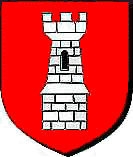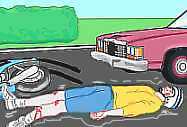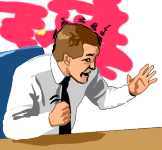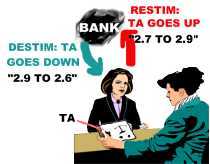
|
C/S Tools: |

|
C/S Tools: |
What the C/S is Doing
What is important in determining the success of a C/S program is TA action. Ideas and significances play a secondary role. The pc is more interested in significances and explanations in his life. That certainly plays a role, but it is junior to handling the force of incidents and masses. When you get the force handled the significance will also be handled and the pc's ability to think and act in the area gets straightened out.
 |
When the Force in this Engram is |
This is best illustrated by Engram running by Chains. That there were incidents that actually contained force (Engrams) below the surface of Locks and Secondaries was the big discovery of 1950. Prior to that therapists had endlessly tried to find explanations for aberration in various significances and light incidents as far as force is concerned. "The reason you are afraid of birds is, that your mother said that 'birds carry disease' when you were five". Such an incident would at best be a Lock on a real Engram. It would derive its aberrative value from the force in the underlying Engram or Engrams which would be unknown to the pc.
Almost all strange ideas and chronic somatics have their root in force of one kind or another.
To handle anything, including anything to do with bodies, involve force. To be unable to handle things are closely connected to the thetan's inability to handle the force contained in his mind. Objection to force and inability to deal with it is what lead to odd ideas and mental derangement.
Objection to force deteriorates to a point where the thetan wishes to stop things. Below that the thetan goes into a state of overwhelm. Part of overwhelm is propitiation and obsessive agreement with strange ideas.
 |
 |
|
Low TA is caused by |
High TA is caused by |
Force and TA Position
A low TA (below 2.0 - no "false TA") means the pc is overwhelmed by
masses. The pc has gone past the point of wanting to stop things. A low TA case
is in life unable to handle real or imaginary forces.
A chronically high TA means the pc can still stop things and is trying to do so.
In auditing high TA can also mean other things. If the pc was run on Engrams and has high TA at the end or shortly after such session it would mean the Engram Chain was unflat. The TA registers the force contained in the Chain that is still there in part.
In Auditors Rights we said "High TA equals overrun", meaning doing something too long. The pc has been doing something that has Engrams connected with it for too long and these Engrams have been restimulated by auditing and life. If one just kept overrunning and overrunning this thing the pc would in theory end up with a low TA.
Handling Masses
So the C/S is basically handling masses, forces and energies on any pc. He has
to understand this thing completely. If he takes off and tries to handle
significances only - maybe because that is what the pc keeps talking about - he
looses track of what makes auditing effective and most psycho-therapy mainly
restimulative.
The Reactive Mind with its Engrams, Secondaries, etc. contains mental masses, forces, energies, time, which express themselves as pains, misemotions, strange ideas and perceptions. All these are buried as significances in the masses of the Reactive Mind.
The pc will constantly be talking about the significances of these masses and forces. The C/S understands, that the significances come into view and "talks to the pc" as a result of actually contacting the masses and forces that hold them in place. So the C/S' job is to keep contacting masses and forces and have the pc itsa the significances as they fly by. To go astray and chase the significances will cause the TA to stop moving and the pc stop having gains.
So the C/S is basically handling masses, forces and energies on any pc. He has to understand this thing completely. If he takes off and tries to handle significances only - maybe because that is what the pc keeps talking about - he looses track of what makes auditing effective and most psycho-therapy mainly restimulative.
The Reactive Mind with its Engrams, Secondaries, etc. contains mental masses, forces, energies, time, which express themselves as pains, misemotions, strange ideas and perceptions. All these are buried as significances in the masses of the Reactive Mind.
The pc will constantly be talking about the significances of these masses and forces. The C/S understands that the significances come into view and "talks to the pc" as a result of actually contacting the masses and forces that hold them in place. So the C/S' job is to keep contacting masses and forces and have the pc itsa the significances as they fly by. To go astray and chase the significances will cause the TA to stop moving and the pc stop having gains.
 |
When the TA is moving the pc |
The Meter and Force
The Meter registers the changes of masses and force on the case. Every Fall and
Blowdown means a discharge is taking place. When the TA is moving the pc will
have cognitions. The cognitions being the high point of the significances
released from the Bank. So there are two reliable indicators to C/S by:
1. Needle and TA action
2. Cognitions
The TA action shows force coming off. Cognitions show theta being regained and released from the force. To "Parallel what the mind is doing" The C/S depends on pc's statement and good Meter reactions.
C/S Parallels what the Mind is Doing
This doesn't mean the pc is always wrong in what
he thinks and states about his case. He is generally right when he says he's
overwhelmed or upset. He's almost always wrong when he says what
overwhelmed him or what BPC was in restimulation. If what he says is spot on
(such as an experienced auditor as pc can be) it will simply produce an F/N VGIs
and be done with and does not tell the C/S what to correct as it is already
fixed.
The C/S will always use the pc's data one way or the other as he is trying to parallel what the mind does. But that has to be seen on the Meter as reads and Blowdowns to be valid. Not simply because the pc says so.
Always remember that what's really wrong lies in the field of mass, energy, space, time, form and location. As these are being eased up thoughts come to view. So if you Q and A with thoughts already in full view you never really ease up the Bank. That's why Q and A with significance is not done.
Use of Charts and Scales
A C/S should be able to spot his pc on "Self Analysis'" Chart of
Attitudes and "Science of Survival's" Chart of Human
Evaluation and the different Scales (see tone
scale chapters and appendix). This is of great use to him. When he
finds the pc on one of its columns he can see if the pc stays there or moves up
or down. If a pc is staying at the same level or falls he knows the pc is being
run above his level of reality.
This doesn't mean the pc is always wrong in what he thinks and states about his case. He is generally right when he says he's overwhelmed or upset. He's almost always wrong when he says what overwhelmed him or what BPC was in restimulation. If what he says is spot on (such as an experienced auditor as pc can be) it will simply produce an F/N VGIs and be done with and does not tell the C/S what to correct as it is already fixed.
The C/S will always use the pc's data one way or the other as he is trying to parallel what the mind does. But that has to be seen on the Meter as reads and Blowdowns to be valid. Not simply because the pc says so.
Always remember that what's really wrong lies in the field of mass, energy, space, time, form and location. As these are being eased up thoughts come to view. So if you Q and A with thoughts already in full view, you never really ease up the Bank. That's why Q and A with significance is not done.
Use of Charts and Scales
A C/S should be able to spot his pc on "Self Analysis'" Chart of
Attitudes and "Science of Survival's" Chart of Human
Evaluation and the different Scales (see tone
scale chapters and appendix). This is of great use to him. When he
finds the pc on one of its columns he can see if the pc stays there or moves up
or down. If a pc is staying at the same level or falls he knows the pc is being
run above his level of reality.
Processing changes conditions. If it doesn't improve them (or the pc's behavior) then the pc's reality is not being reached. It can be above or below. It is seldom that the pc's reality is higher than the processes used and this usually only occurs when a Grade, already run, is rerun. Then you get pc protest as he has made that.
Pc's who get sick suddenly should be suspected of being run on processes too high for their reality. Pcs who don't change are usually also run too high.
Behavior, mannerisms are the index. If they change the pc is improving. If they drop lower on the Human Evaluation Charts the pc is in overwhelm. Picking thoughts out of forces in the Bank does not bring about change. In other words you can park a pc by continuing nothing but think processes and addressing only significance.
The pc will change his basic ideas when he changes his relationship to forces. Many processes do this, including Objective Processes. Somatics turning on and off in session are a definite sign of force blowing off. The no-somatic pc is either way high on the charts or, more likely, being run too high. You don't have to run directly at force for forces to change in the pc. Even 2 way comm's can release huge bundles of forces!
The body responds badly to forces. The conflict between protecting or using a body and as a thetan being able to withstand large forces gets so mixed up in a pc he can end up as a force-shy being. What the C/S has to realize is, that he is (a) producing an optimum rate of change in the pc if he is C/Sing well and, (b) changing the pc's position upward on the Chart of Human Evaluation and all Scales.
Flattening Grades and RD's
The way a Grade is supposed to be run is,
1) Have the pc set up for the Grade so his attention is not on something else, but on the processes so they are real and biting.
2) Work the TA into the processes. This means the pc is actually confronting the masses and energies of the Grade. Good TA means pc is having gains, whether he can see it right away or not.
3) Good TA leads to important cognitions for the pc. Now he knows he is winning at it. His needle will become looser and more responsive.
4) Towards the completion of a Grade or RD the TA will slow down. The pc will have less spectacular cognitions. This means the pc has confronted most of what is there and he is closing in on completing that Grade or RD.
5) At the end of such a run the pc will have absolute certainty on that he has regained the ability of the Grade or RD. The Grade has been completely discharged and the pc will gladly and with conviction attest to the end result - ability regained.
|
To complete a Grade the pc |
F/N's and Grades
The EP of a Major Action is F/N, VGI's, cognition and release
That is however not the full EP
of a Release Grade (Grade 0-4). To complete a Grade the pc has to have all the
force handled on the subject and he will have big cognitions directly at the
subject as a result. This comes about by obtaining EP after EP on the Grades 0-4
processes. You will typically see this cycle: the TA will be worked into the
processes. Each consecutive session will show an increased amount of TA per
hour. The cognitions will become bigger and bigger, meaning go directly to the
subject being handled in a broad way.
At some point the TA will start to slow down; (also, often the cognitions will more be a sort of clean-up job - afterthoughts that supports the big ones the pc had earlier). Seeing the TA slow down after a good run with major cognitions you know he has made it and can send him to attest with confidence.
But don't cut the Grade short unless going on means the TA starts to shoot up.
If the TA starts to go up after a big win, even in a later session, you most likely need to rehab and validate the wins the pc had. That may be the whole subject matter of that Grade or it may just be one important step in that direction. You have to decide based on the whole picture what you have got. Has the pc on his own expressed ability regained? Does the amount of TA and trail of cognitions tell you that he has actually completed the Grade?
It would be very unusual to cut the use of all processes for a Grade short. It is better to err to the side of caution if you are in doubt. Send the pc away, after rehabbing the wins, to enjoy them for a couple of days. When he comes back you will know if he actually made it. If the slightest doubt exists, take up the next processes on the Grade and see if he is still winning and getting gains. In some rare cases it is probably the right thing to send him to attest the Grade you have been working on.
As a C/S you are there to make sure the pc makes gains and attains the actual abilities of each Grade. They are there to be had if you follow the principles laid out here, including the set-up for the Grade in the first place. The C/S is there to help the pc through each Grade. He does that by making sure the auditor audits with good TRs, good metering and each process done is taken to it End Phenomena. Doing that the pc will make it. And that is what the C/S is doing. He keeps the activity on track and the TA moving and the pc winning and pc moving through the Grades.
|
Home Search Level 0 Level 1 Level 2 Level 3 Level 4 Level 4Pro Level 5 C/Sing Solo |
|
|
| Tech terms | Scales | Axioms | Drills | Checksheets | Processes | Prep. lists | C/S terms | C/S tool | Grades | Cramm | Points | KTW | Online | |